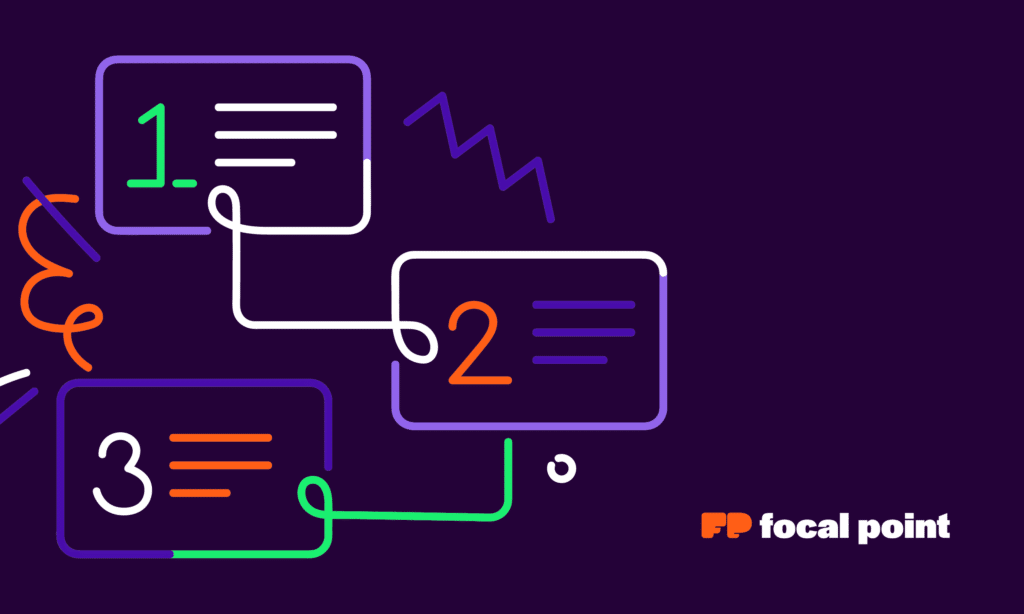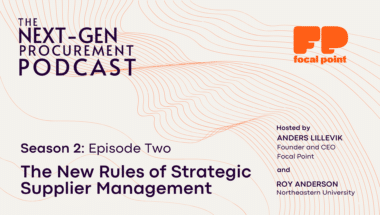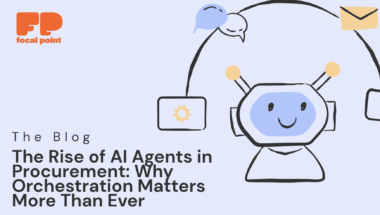With the level of complexity enterprise procurement teams face today, staying ahead means embracing digital transformation. Focal Point is helping teams do just that with a purpose-built, advanced Procurement Platform for business process orchestration – a hot topic for companies looking to boost efficiency and achieve success.
By integrating automation, smart workflows, and your existing data, you can streamline your operations, improve visibility and increase cost savings. But what is orchestration, really?
Process orchestration goes beyond simple automation. It provides a bird’s-eye view of your entire business process, allowing you to adapt quickly to market changes as you can see a holistic view of your organization.
This approach empowers your team to focus on strategic tasks while automating routine and manual work.
Key Takeaways
- Process orchestration enhances operational efficiency by automating repetitive and manual tasks
- It improves visibility and control over business workflows
- Workflow automation tools are essential for successful orchestration
- Integration of existing systems enhances communication and data visibility
- 80% of enterprises are expected to adopt orchestration technology by 2025
- Real-world examples show significant time and cost savings through orchestration
Why We Need Process Orchestration
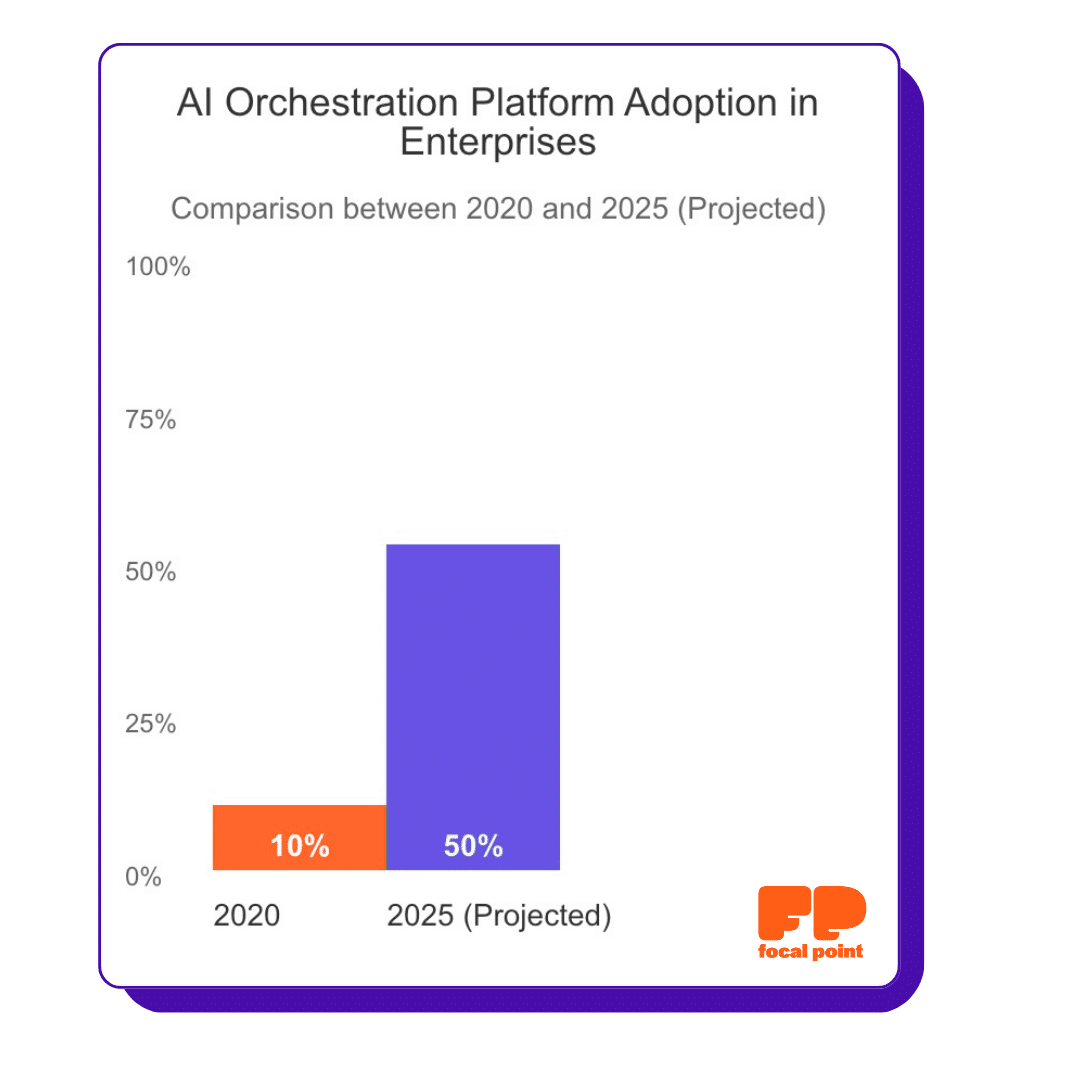
The impact of process orchestration is substantial. For example:
According to Gartner, by 2025, 50% of enterprises will have devised artificial intelligence (AI) orchestration platforms to operationalize AI, up from fewer than 10% in 2020.
AI orchestration platforms in enterprises are becoming essential for effectively operationalizing AI and business process management.
Understanding the Symphony of Business Processes
Business process orchestration is like conducting a symphony. It harmonizes workflows, technology, and people to create a seamless end-to-end process, which brings efficiency and success to your business operations.
What is Process Orchestration?
Process orchestration is a comprehensive philosophy work working: managing and automating complex business processes across multiple systems and departments. It involves coordinating, synchronizing, and monitoring various automated workflows to ensure they operate smoothly and deliver the expected results.

Effective Business Process Orchestration and Automation
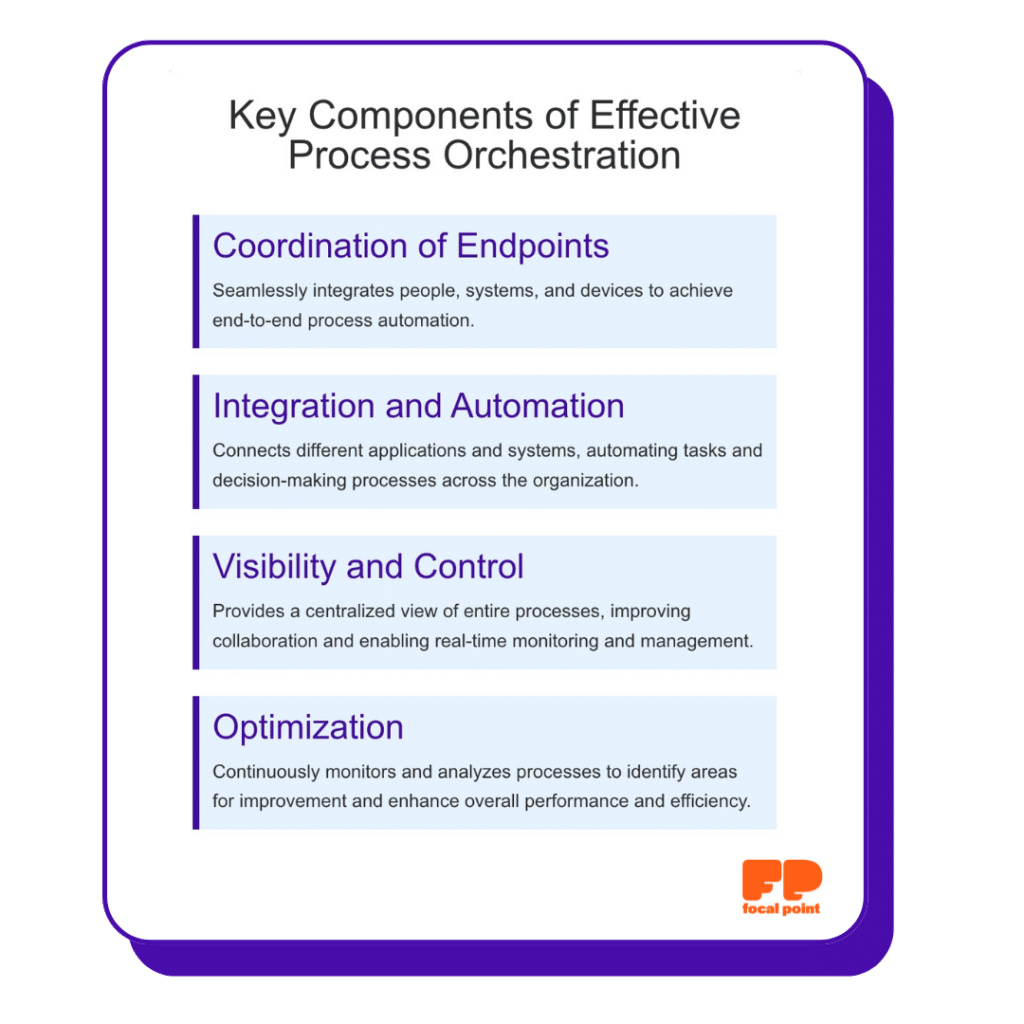
Effective orchestration relies on several critical elements as we have displayed in the image above:
- Coordination of Endpoints: Process orchestration coordinates the various moving parts (or endpoints) of a business process, including people, systems, and data. It ensures all these components work together seamlessly to achieve end-to-end process automation.
- Integration and Automation: It integrates existing applications and systems, automating tasks, workflows, and decision-making processes across organizational systems. This integration helps eliminate manual errors, reduce lead times, and enhance efficiency and productivity, without ripping out existing infrastructure.
- Visibility and Control: Process orchestration provides a centralized view of the entire process, improving team collaboration and communication. It allows for real-time monitoring and management of workflows, ensuring any issues can be quickly identified and addressed.
- Optimization: By continuously monitoring and analyzing processes, orchestration tools can identify areas for improvement and optimize workflows to enhance performance and efficiency.
These components work together to streamline operations and identify areas for improvement.
The Role of Automation in Process Orchestration
Automation tools play a crucial role in orchestration. They apply the right solutions at the right time to optimize complex business processes. This can lead to a 15% increase in operational efficiency within 6 months.
Orchestration also boosts employee satisfaction by automating repetitive tasks, allowing your team to focus on more strategic, value-creating work.
Implementing business process orchestration can significantly impact your operations. It can reduce missed SLA occurrences and increase client satisfaction by an average of 33%.
According to the Expert Market Research report, the global process automation market reached a value of almost USD 202.54 billion in 2023. The market is expected to grow at a Compound Annual Growth Rate (CAGR) of 6.6% between 2024 and 2032. For more detailed insights, refer to the global process automation market growth.
The Power of End-to-End Visibility in Process Orchestration

End-to-end visibility is a game-changer in process orchestration. It gives you a complete view of your operations from start to finish, making it easier to track progress and identify bottlenecks.
Process monitoring tools provide real-time insights into your operations. These insights are crucial for quick decision-making and proactive problem-solving.
Here’s how end-to-end visibility empowers your business:
- Identifies bottlenecks and inefficiencies
- Enables continuous performance measurement
- Supports automated root cause analysis
- Allows for fine-tuning of workflows
Leveraging these capabilities can boost productivity. This improvement comes from automating repetitive tasks and optimizing resource allocation. End-to-end visibility also helps reduce downtime, leading to faster issue resolution and improved customer satisfaction.
Remember, 96% of businesses view automation as critical for digital transformation. By embracing end-to-end visibility in your process orchestration, you’re setting your business up for success in the digital age.
Streamlining Workflows for Optimal Performance
Workflow optimization is key to boosting your business efficiency. By streamlining workflows, you can avoid process bottlenecks and enhance overall performance. This approach involves identifying process weak points, integrating data from existing systems (such as S2P solutions), and refining automation efforts.
Identifying and Eliminating Process Bottlenecks
Recognizing process bottlenecks is the first step toward efficiency improvement. These bottlenecks slow down operations and hinder productivity. By using workflow orchestration tools, you can gain real-time visibility into your processes.
This insight lets you pinpoint and address issues promptly, leading to smoother operations.
Integrating Diverse Endpoints and Systems
System integration is crucial for seamless operations. It involves connecting various endpoints, from mobile devices to existing supplier or risk management solutions, ensuring smooth data flow across your organization.
You create a unified workflow that enhances efficiency and reduces errors by linking different systems – eliminating manual data stitching.
Optimizing Existing Automation Efforts
Automation optimization is about refining your current automated processes. It involves coordinating separate automated operations to work together effectively.
This approach transforms manual or inefficient processes into streamlined, automated workflows. As a result, you reduce errors and free up human resources for more valuable tasks.
- Use workflow orchestration tools to simplify process design
- Implement real-time monitoring to track performance
- Leverage orchestration architecture for scalability and flexibility
- Ensure compliance through standardized processes
Focusing on these areas can significantly improve your workflow efficiency.
Process Orchestration: Bridging the Gap Between Automation and Strategy
Process orchestration is the key to unlocking your business’s full potential. It seamlessly connects automation and strategy, aligning your automated processes with your business objectives.
This approach goes beyond simply automating individual tasks, creating a cohesive end-to-end strategy for operational efficiency.
Strategic orchestration enables your organization to adapt swiftly to changing business needs. By integrating automation efforts strategically, you can achieve significant cost savings, accelerate deal closures, and minimize errors.
According to SNS Insider, the Process Orchestration Market is expected to grow from USD 6.29 billion in 2023 to USD 27.61 billion by 2031, with a CAGR of 20.3% over the forecast period of 2024-2031., highlighting its increasing importance in digital transformation.
Your automation strategy should focus on:
- Aligning automated processes with business goals
- Optimizing resource utilization
- Enhancing visibility into existing workflows
By 2025, over 70% of organizations relying on workload automation will adopt Strategic Orchestration and Automation Platforms (SOAPs) for seamless coordination within IT and business domains. This shift emphasizes the growing recognition of process orchestration’s role in driving operational efficiency and achieving business objectives.
Embrace process orchestration to bridge the gap between your automation efforts and overall strategy. This approach will empower your organization to thrive in an increasingly competitive digital landscape, fostering innovation and driving success across all aspects of your business.
Implementing Process Orchestration: A Step-by-Step Approach
Process implementation requires a systematic approach to achieve optimal results. Following the following step-by-step method, you can effectively orchestrate your business processes and maximize efficiency.
Measuring Your “As Is” Process
Start by evaluating your current workflows. Use process mining tools to visualize and analyze existing processes. This step provides a 360-degree view of your operations, helping identify areas for improvement.
Prioritizing Data Architecture
Next, focus on your data architecture. Implement a data fabric within your process automation platform. This approach unifies data from multiple systems, enhancing workflow efficiency and providing secure access to enterprise data.
Connecting People, Processes, and Systems
The final step involves creating collaborative workflows. Procurement Orchestration tools, like Focal Point, streamline operations, connecting employees, partners, and customers for better experiences.
- Use low-code/no-code UX to accelerate automation implementation
- Ensure enterprise-grade security with role-based access control
- Leverage AI to facilitate partnerships between machines and people
This approach will create a comprehensive process orchestration system that drives efficiency and success across your business operations.
Realizing the Benefits of Business Process Orchestration
Process orchestration benefits are transforming businesses across industries. A recent Tata Consultancy Services and AWS survey found that 70% of global companies consider legacy modernization a top strategic priority. This shift towards digital transformation is driving the adoption of process orchestration tools.
One key benefit of process orchestration is improved operational efficiency. By streamlining workflows and automating repetitive tasks, businesses can reduce errors and boost productivity. This leads to significant cost reductions, as resources are utilized more effectively.
Another advantage of process orchestration is its scalability. As your business grows, these systems can easily adapt to handle increased workloads without compromising performance. This flexibility ensures that your operations can expand seamlessly to meet changing demands.
- Reduced operational costs through optimized resource utilization
- Enhanced efficiency in deal closure and error reduction
- Improved scalability to adapt to evolving business needs
Employee satisfaction is also positively impacted by process orchestration. Employees can focus on more engaging and strategic work by eliminating tedious manual tasks. This shift often leads to higher job satisfaction and improved overall productivity.
Many process orchestration platforms’ low-code/no-code approach empowers non-technical staff to participate in process optimization. This democratization of workflow management fosters innovation and encourages cross-departmental collaboration, further enhancing operational efficiency.
For more information, Read Your Guide to Procurement Orchestration
Conclusion
Business process orchestration has emerged as a transformative force in the quest for operational excellence and digital transformation. As organizations navigate the complexities of modern business landscapes, solutions like Focal Point’s advanced Procurement Platform stand out as powerful tools for integrating, automating, and optimizing critical workflows.
The benefits of embracing process orchestration are clear and compelling:
– Streamlined operations and reduced costs
– Enhanced visibility and control over business processes
– Improved employee satisfaction through automation of repetitive tasks
– Increased agility to adapt to market changes
– Significant time and cost savings, as evidenced by real-world examples
As we look towards 2025 and beyond, the integration of AI and machine learning in process orchestration tools promises even greater advancements. These technologies will not only analyze data but make intelligent decisions, further elevating operational excellence across industries.
However, the journey to mastering process orchestration is ongoing. It requires continuous monitoring, performance measurement, and a commitment to improvement. By embracing this approach, you’re not just streamlining workflows – you’re positioning your organization for long-term success in an increasingly digital world.
Are you ready to unlock the full potential of your business processes? Focal Point’s Procurement Platform offers a comprehensive solution to your orchestration needs. From providing a bird’s-eye view of your operations to integrating cutting-edge AI capabilities, our platform is designed to drive efficiency and success.
Don’t let your business fall behind in the race for digital transformation. Take the first step towards optimizing your operations today. Book a demo with Focal Point and discover how our advanced Procurement Platform can revolutionize your business process orchestration. Let us show you the future of work – where efficiency, innovation, and success harmoniously come together.
